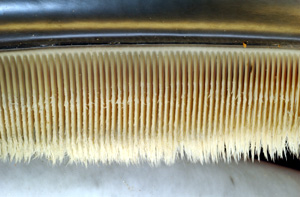
Baleen plates
There are two types of whales: baleen whales (Mysticeti) and toothed whales (Odontoceti). And you might have deduced from this statement that baleen is what some whales use instead of teeth.
Baleen is made of keratin, the same protein found in human hair and fingernails. And just like our hair and fingernails, baleen is constantly growing! Imagine if your teeth were constantly growing, that could become a serious problem. But for baleen whales this set-up seems to work well.
Baleen consists of hundreds of individual plates that hang from the upper jaw of a whale’s mouth. The number of plates depends on the species of whale and also the individual whale. For example, gray whales typically have 130 to 180 plates on each side of their mouth. But the color and length also varies across species. Gray whales have creamy colored baleen that averages 1.5 feet in length, while a blue whale’s baleen is black and more than three feet long. Interestingly enough, according to the Encyclopedia of Marine Mammals the species belonging to Balaenoptera (the genus of whales that includes the blue, fin, sei, minke and bryde’s) have at least a few all white plates at the very front of the mouth, except for the blue whale. A baleen whale’s version of a gold tooth.
From the outside, a whale’s baleen looks like thin plates stacked side by side, but on the inside baleen resembles a dense mat of hair. This thick mat acts like a built in strainer, allowing baleen whales to catch the tiniest ocean critters for dinner without problem while filtering the water out. For example, blue whales feed almost exclusively on krill. But some krill only grow to be an inch long. So if the blue whale had teeth, tiny krill would slide out of the whale’s mouth through the cracks between the teeth. Hence, the need for baleen.
Unfortunately for baleen whales, humans found a use for baleen making whaling a very profitable industry. According to the Encyclopedia of Marine Mammals, baleen was used for umbrella ribs, corsets, and skirt hoops and the hairy matted side was used for brooms and brushes. Thankfully, the commercial market for baleen came to an end in 1930, but that wasn’t the end of whaling.
I never knew anything about this. Awesome post!